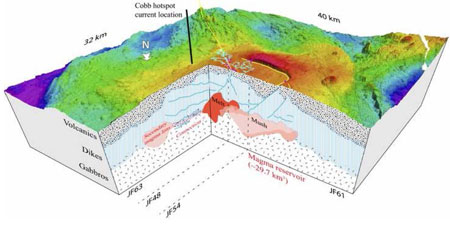Anatomy of an active submarine volcano
By:
Adrien Arnulf
University of California, San Diego
| When: | Friday, January 17, 2014, 10:30 a.m. to 11:30 a.m. Join us for coffee beginning at 10:00 a.m. |
| Where: | Seminar Conference Room, 10100 Burnet Road, Bldg 196-ROC, Austin, Texas 78758 |
| Host: | Harm Van Avendonk, UTIG |
Click for a Live Broadcast.

Abstract
Most of the magma erupted at mid-ocean ridges is stored in a mid-crustal melt lens that lies at the boundary between sheeted dikes and gabbros. Nevertheless, images of the magmatic plumbing system linking the melt lens to the overlying eruption site have remained elusive. Here, we have combined full waveform inversion (FWI) and reverse time migration (RTM) of multichannel seismic (MCS) data to present accurate, high-resolution images of the magmatic system underlying Axial volcano that straddles the Juan de Fuca Ridge.
Our results reveal a complex melt body beneath the summit caldera, which is approximately 14 km long, 3 km wide and up to 1 km thick. The estimated volume of the reservoir is 29.7 km3, more than two orders of magnitude greater than the erupted magma volumes of the 1998 and 2011 eruptions. Our images show a network of sub-horizontal to shallow dipping (<30?) features that we interpret as the plumbing system facilitating melt transport beneath the central volcano to the 1998 and 2011 eruption sites. These images also reveal a subsiding caldera floor that provides a near perfect trap for the ponding of lava flows, supporting a "trapdoor" mechanism for caldera formation as in some sub-aerial volcanoes.




